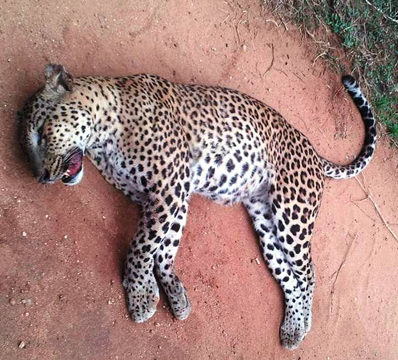Let’s save Yala
Letter to the Minister for Sustainable Development and Wildlife,
Dear Sir,
|

A leopard found dead in the Yala precincts |
We write to you in the hope that action would be taken to bring to an
end animals being runover in the Yala National Park.
Yala, being the second largest and most visited national park in Sri
Lanka, is home to about 250 species of wildlife including the endemic
and endangered mammal, Pantharapaduskotiya, commonly known as the Sri
Lankan leopard. However, despite its significance there has been little
regard for its sustenance.
Blatant disregard
Due to the alarming rise of blatant disregard for the protection of a
national heritage, a group of young wildlife enthusiasts have created a
petition to address this issue on Change.org titled ‘President of Sri
Lanka – Maithripala Sirisena, Prime Minister of Sri Lanka – Ranil
Wickramasinghe: Put a stop to the wild animals being run over by safari
jeeps in Yala, Sri Lanka.’
To date, the petition has over 5,000 signatures and it consists of a
representation of individuals from over 96 different countries, in
addition to which a total of 45 countries across the world has raised
awareness with regard to this issue.
The individuals in question have also prepared an inclusive proposal
with suggestions gathered from the signitaries of the petition, youth
wild-life enthusiasts and experienced wildlife activists in Sri Lanka. A
comprehensive budget, complete with revenue forecasts have also been
computed to demonstrate the feasibility of implementing such measures in
the National Park.
Primary Issues that have been addressed in the proposal include the
hit and run vehicle accidents, over visitation, use of mobile phones
within the park and non-adherence to park rules and regulations,
Secondary issues that have been addressed are ‘Pollution and smoking’
and ‘Education on conservation.’
The gravity of the issue of vehicle accidents is self explanatory
with the many incidents that have raised concerns recently with regard
to the safety of these animals.
The following being some of the reported incidents;
June 2012 - a Jungle cat was killed by a hit and run jeep.
October 2012 - a carcass of a young leopard was found near
Patanangala whose death was due to a speeding vehicle.
August 2015 - a doe and her fawn were killed by a speeding vehicle, a
deer was hit by a motorist and left to die on the
Kirinda-Palatupana-Yala road, a Leopard was found dead in and suspected
to have been killed in a road accident.
Several testimonials indicate the severity of the issue,
“I have seen it with my eyes, one tracker tells the other that a
leopard has been sighted and the tracker receiving the information
drives like an absolute imbecile to get there in time, meanwhile killing
at least a couple of birds on the way” -Anithra Basnayake, Australia
“I have been to Yala several times and have witnessed first hand the
hounding of wild animals and the irresponsible driving of the jeep
drivers” -Francoise Caulier, Belgium
“Being an animal lover and a great admirer of the Yala National Park,
this needs to stop. It’s a life not just a single animal. It is our duty
to protect and not destroy what we have”.
- Jason Eardly, Sri Lanka
The issue of over visitation has reached crisis proportions and this
is affecting the natural behaviour of wildlife, creating unhealthy
conditions. Hundreds of smaller animals and occasionally larger animals
are often run over by speeding jeeps which exacerbate the over
visitation issue. Discipline of jeep drivers has decreased due to high
competition among parties to give the best sighting to clients. All
these issues have been addressed in the proposal and draft reforms which
have been suggested.
The group’s objective is to promote conservation and sustainable
tourism. Conservation to protect the ecosystem and to create awareness
giving emphasis to endemic and endangered species and for the park to be
used to educate individuals of the importance of conservation and the
role played by its inhabitants to the delicate balance of our ecosystem.
In the case of sustainable tourism and the economy, it is to maintain
this and boost the economy of the dependent community in a more
sustainable manner.
Further goals include:’ improving the governance of the tourism
industry in the Yala National Park through education, awareness,
instilling the concept of sustainable tourism in the community,
conservation of wildlife in the Yala National Park and safeguarding its
diversity within its ecosystem whilst enhancing the livelihood of the
local community.
It must also be mentioned that awareness has been created through
social media via www.facebook.com/saveyala “Call to action and pass a
regulation on safeguarding the animals of the National Park” and the
media campaign has proved to be largely successful.
This letter is addressed to you to secure a meeting to discuss the
afore mentioned proposal.
|

